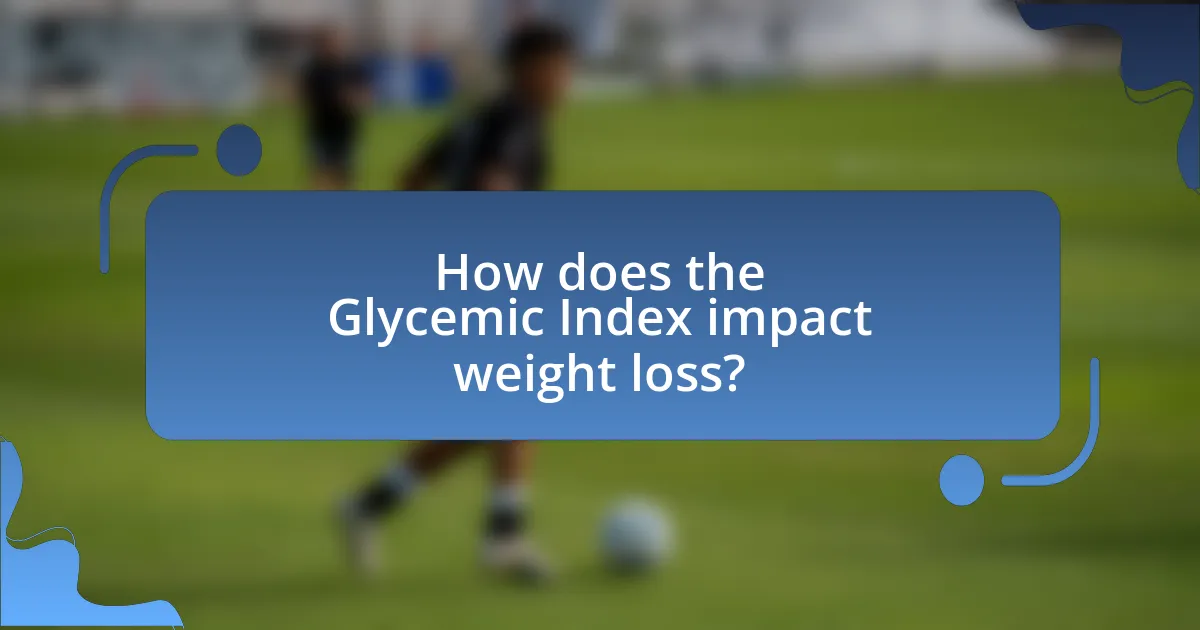The Glycemic Index (GI) is a numerical scale that ranks carbohydrates based on their effect on blood glucose levels, categorizing foods into low, medium, and high GI values. This article explores how the GI is measured, its significance in health and weight management, and its role in diabetes management. It discusses the impact of food types on GI, the relationship between GI and appetite control, and practical tips for incorporating low-GI foods into daily diets. Additionally, the article addresses criticisms of the GI, including individual variability in responses and the importance of considering overall nutritional quality.

What is the Glycemic Index?
The Glycemic Index (GI) is a numerical scale that ranks carbohydrates in foods based on their impact on blood glucose levels. Foods with a high GI are rapidly digested and absorbed, causing a swift increase in blood sugar, while low GI foods result in a slower, more gradual rise. For example, white bread has a high GI of around 70, whereas lentils have a low GI of approximately 30. This classification helps individuals make informed dietary choices, particularly for managing weight and blood sugar levels.
How is the Glycemic Index measured?
The Glycemic Index (GI) is measured by comparing the blood glucose response of a test food to that of a reference food, typically glucose or white bread. In a controlled study, participants consume the test food after fasting, and their blood glucose levels are measured at intervals over a two-hour period. The area under the blood glucose response curve is calculated, and the GI is determined by dividing this area by the area for the reference food, then multiplying by 100. This method provides a standardized way to assess how quickly and significantly a carbohydrate-containing food raises blood glucose levels, which is crucial for understanding its impact on weight loss and overall health.
What are the different categories of Glycemic Index values?
The different categories of Glycemic Index (GI) values are classified as low, medium, and high. Low GI foods have a value of 55 or less, medium GI foods range from 56 to 69, and high GI foods are 70 or above. This classification is based on how quickly carbohydrates in food raise blood glucose levels, with low GI foods causing a slower, more gradual increase, which can be beneficial for weight management and overall health.
How do food types influence their Glycemic Index?
Food types significantly influence their Glycemic Index (GI) by determining how quickly carbohydrates in the food are digested and absorbed into the bloodstream. For example, foods high in simple sugars, such as white bread and sugary snacks, typically have a high GI because they are rapidly broken down, leading to quick spikes in blood glucose levels. In contrast, foods rich in fiber, such as whole grains and legumes, have a lower GI as the fiber slows digestion and absorption, resulting in a more gradual increase in blood sugar. This relationship is supported by research indicating that the composition of carbohydrates, including their structure and the presence of other nutrients, directly affects their GI values.
Why is the Glycemic Index important for health?
The Glycemic Index (GI) is important for health because it measures how quickly carbohydrate-containing food raises blood glucose levels. Foods with a high GI can lead to rapid spikes in blood sugar, which may increase the risk of type 2 diabetes and cardiovascular diseases. Conversely, low-GI foods promote gradual increases in blood sugar, aiding in better blood sugar control and potentially supporting weight management. Research indicates that diets emphasizing low-GI foods can improve overall health outcomes, including reduced risk of obesity and related metabolic disorders.
How does the Glycemic Index affect blood sugar levels?
The Glycemic Index (GI) affects blood sugar levels by ranking carbohydrates based on their impact on blood glucose after consumption. Foods with a high GI cause rapid spikes in blood sugar, while low GI foods lead to gradual increases. For example, white bread has a high GI of around 70, resulting in a quick rise in blood sugar, whereas lentils have a low GI of approximately 30, promoting a slower, more stable increase. This difference in blood sugar response can influence insulin secretion and overall metabolic health, making low GI foods beneficial for managing blood sugar levels and supporting weight loss efforts.
What role does the Glycemic Index play in diabetes management?
The Glycemic Index (GI) plays a crucial role in diabetes management by categorizing foods based on their impact on blood glucose levels. Foods with a low GI are digested and absorbed more slowly, leading to a gradual rise in blood sugar, which is beneficial for individuals with diabetes as it helps maintain stable glucose levels. Research indicates that diets emphasizing low-GI foods can improve glycemic control and reduce the risk of complications associated with diabetes. For instance, a study published in the American Journal of Clinical Nutrition found that low-GI diets significantly lowered HbA1c levels, a key marker for long-term blood sugar control.

How does the Glycemic Index impact weight loss?
The Glycemic Index (GI) impacts weight loss by influencing blood sugar levels and appetite regulation. Foods with a low GI lead to slower digestion and a gradual release of glucose, which helps maintain stable energy levels and reduces hunger. Research indicates that low-GI diets can promote weight loss; for instance, a study published in the American Journal of Clinical Nutrition found that participants on a low-GI diet lost more weight compared to those on a high-GI diet over a 12-week period. This evidence supports the idea that incorporating low-GI foods can be an effective strategy for weight management.
What is the relationship between Glycemic Index and appetite control?
The Glycemic Index (GI) influences appetite control by affecting blood sugar levels and satiety. Foods with a low GI lead to a slower release of glucose into the bloodstream, which helps maintain stable energy levels and reduces hunger. Research indicates that low-GI diets can enhance feelings of fullness and decrease overall calorie intake, as evidenced by a study published in the American Journal of Clinical Nutrition, which found that participants consuming low-GI foods reported lower hunger levels and reduced food intake compared to those consuming high-GI foods. This relationship suggests that managing GI can be an effective strategy for appetite regulation and weight management.
How do low-GI foods influence satiety?
Low-GI foods enhance satiety by promoting a gradual release of glucose into the bloodstream, which helps maintain stable blood sugar levels. This slow digestion process leads to prolonged feelings of fullness compared to high-GI foods, which cause rapid spikes and subsequent drops in blood sugar. Research indicates that individuals consuming low-GI diets report lower hunger levels and reduced calorie intake, contributing to effective weight management. For instance, a study published in the American Journal of Clinical Nutrition found that participants on a low-GI diet experienced greater satiety and consumed fewer calories overall, supporting the role of low-GI foods in appetite regulation.
What are the effects of high-GI foods on hunger levels?
High-GI foods increase hunger levels shortly after consumption. This occurs because high-GI foods cause rapid spikes in blood glucose followed by quick declines, leading to feelings of hunger soon after eating. Research indicates that foods with a high glycemic index can lead to increased appetite and subsequent calorie intake, as evidenced by a study published in the American Journal of Clinical Nutrition, which found that participants consuming high-GI meals reported greater hunger levels compared to those consuming low-GI meals.
How can the Glycemic Index guide food choices for weight loss?
The Glycemic Index (GI) can guide food choices for weight loss by helping individuals select foods that have a lower impact on blood sugar levels. Foods with a low GI are digested more slowly, leading to a gradual release of glucose into the bloodstream, which can help control hunger and reduce overall calorie intake. Research indicates that diets emphasizing low-GI foods can lead to greater weight loss compared to high-GI diets, as evidenced by a study published in the American Journal of Clinical Nutrition, which found that participants consuming low-GI diets experienced significant reductions in body weight and fat mass. Thus, incorporating low-GI foods into a weight loss plan can enhance satiety and support better weight management.
What are some examples of low-GI foods beneficial for weight loss?
Examples of low-GI foods beneficial for weight loss include lentils, chickpeas, quinoa, sweet potatoes, and most fruits such as apples and berries. These foods have a low glycemic index, which means they cause a slower rise in blood sugar levels, promoting sustained energy and reducing hunger. Research indicates that incorporating low-GI foods into a diet can enhance weight loss efforts by improving satiety and reducing overall calorie intake. For instance, a study published in the American Journal of Clinical Nutrition found that participants consuming low-GI diets experienced greater weight loss compared to those on high-GI diets.
How can meal planning incorporate the Glycemic Index?
Meal planning can incorporate the Glycemic Index (GI) by selecting foods that have a low to moderate GI, which helps regulate blood sugar levels and supports weight loss. Foods with a low GI, such as whole grains, legumes, and non-starchy vegetables, are digested more slowly, leading to a gradual release of glucose into the bloodstream. This can prevent spikes in insulin and promote satiety, making it easier to manage hunger and reduce overall caloric intake. Research indicates that diets emphasizing low-GI foods can lead to better weight management outcomes, as evidenced by a study published in the American Journal of Clinical Nutrition, which found that participants consuming low-GI diets experienced greater weight loss compared to those on high-GI diets.

What are the criticisms and limitations of the Glycemic Index?
The Glycemic Index (GI) has several criticisms and limitations, primarily related to its oversimplification of carbohydrate effects on blood sugar. One major criticism is that the GI does not account for the quantity of carbohydrates consumed, as the glycemic load (GL) provides a more comprehensive view by considering both the quality and quantity of carbohydrates. Additionally, individual responses to carbohydrate intake can vary significantly due to factors such as metabolic health, genetics, and the presence of other nutrients in a meal, which the GI does not address. Furthermore, the GI is based on isolated foods rather than mixed meals, making it less applicable to real-world eating patterns. Studies have shown that focusing solely on GI may not lead to significant improvements in weight loss or metabolic health, as evidenced by research published in the American Journal of Clinical Nutrition, which indicates that dietary patterns and overall caloric intake play a more critical role in weight management than GI alone.
Why do some experts question the effectiveness of the Glycemic Index?
Some experts question the effectiveness of the Glycemic Index (GI) because it does not account for the overall nutritional quality of foods or individual metabolic responses. Research indicates that the GI may oversimplify the complex relationship between carbohydrate consumption and blood sugar levels, as factors such as food preparation, portion size, and the presence of other nutrients can significantly influence glycemic response. For instance, a study published in the American Journal of Clinical Nutrition found that the GI of a food can vary widely among individuals, suggesting that personal factors play a crucial role in how carbohydrates affect blood sugar.
What are the potential downsides of focusing solely on Glycemic Index?
Focusing solely on Glycemic Index (GI) can lead to several potential downsides, including neglecting overall nutritional quality and the impact of portion sizes. While GI measures how quickly carbohydrates raise blood glucose levels, it does not account for the nutrient density of foods. For instance, a food with a high GI may be less nutritious than a low GI food, leading to poor dietary choices. Additionally, GI does not consider how different foods affect individuals differently based on factors like metabolism and insulin sensitivity. Research indicates that relying exclusively on GI can result in an imbalanced diet, as it may encourage the consumption of processed foods with a low GI but high in unhealthy fats or sugars. Therefore, a comprehensive approach to nutrition that includes GI alongside other factors is essential for effective weight management and overall health.
How does individual variability affect Glycemic Index responses?
Individual variability significantly affects Glycemic Index (GI) responses due to factors such as genetics, metabolic rate, and gut microbiota composition. These factors influence how different individuals metabolize carbohydrates, leading to variations in blood glucose levels after consuming foods with the same GI. For instance, research indicates that genetic polymorphisms can alter insulin sensitivity and glucose metabolism, resulting in differing GI responses among individuals. Additionally, the gut microbiome plays a crucial role in carbohydrate digestion and absorption, further contributing to these differences. Studies have shown that individuals with distinct gut microbiota profiles can experience varying postprandial glucose responses, even when consuming identical meals.
What are practical tips for using the Glycemic Index in daily life?
To effectively use the Glycemic Index (GI) in daily life, prioritize low-GI foods such as whole grains, legumes, and non-starchy vegetables, as they help maintain stable blood sugar levels. Incorporating these foods into meals can enhance satiety and reduce cravings, which is beneficial for weight management. For instance, choosing brown rice over white rice can lower the overall GI of a meal, leading to better blood sugar control. Additionally, combining high-GI foods with low-GI options can moderate their impact on blood sugar; for example, pairing white bread with protein or healthy fats can slow glucose absorption. Research indicates that diets emphasizing low-GI foods can lead to improved weight loss outcomes and better metabolic health, as shown in studies published in the American Journal of Clinical Nutrition.
How can one effectively track Glycemic Index in their diet?
To effectively track Glycemic Index (GI) in a diet, one should utilize a GI database or app that provides information on the GI values of various foods. These resources categorize foods based on their impact on blood sugar levels, allowing individuals to make informed dietary choices. Research indicates that foods with a low GI (55 or less) can help manage blood sugar levels and support weight loss, as they lead to slower digestion and a more gradual rise in glucose levels. For instance, a study published in the American Journal of Clinical Nutrition found that low-GI diets can improve glycemic control and aid in weight management. By consistently referencing these databases and incorporating low-GI foods into meals, individuals can effectively monitor and adjust their dietary habits to align with their health goals.
What strategies can help maintain a balanced diet while considering Glycemic Index?
To maintain a balanced diet while considering the Glycemic Index (GI), individuals should prioritize low-GI foods, such as whole grains, legumes, fruits, and non-starchy vegetables. These foods release glucose slowly, helping to stabilize blood sugar levels and reduce hunger. Incorporating high-fiber foods can further enhance satiety and improve digestive health, as fiber slows carbohydrate absorption. Additionally, combining carbohydrates with protein or healthy fats can lower the overall GI of a meal, promoting better blood sugar control. Research indicates that diets emphasizing low-GI foods can lead to improved weight management and reduced risk of chronic diseases, as evidenced by a study published in the American Journal of Clinical Nutrition, which found that low-GI diets resulted in greater weight loss compared to high-GI diets over a 12-month period.


